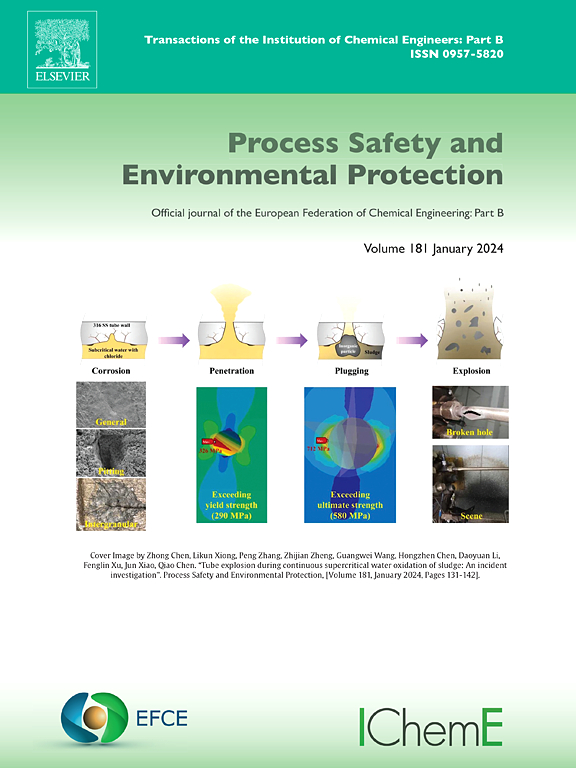铝粘土通过固膜钝化层和S、Fe、Al、Si的形态转变调控黄铁矿的氧化溶解机制
IF 6.9
2区 环境科学与生态学
Q1 ENGINEERING, CHEMICAL
引用次数: 0
摘要
采矿作业中金属硫矿物暴露在氧化条件下,产生酸性矿水(AMD)。本文研究了含铝粘土(AC)包裹体对黄铁矿生物氧化溶解过程中硫(S)、铁(Fe)、铝(Al)和硅(Si)在黄铁矿表面形态变化的影响。结果表明:少量AC(≤4.0 g/L)的加入促进了黄铁矿的生物氧化;反之,加入更大量的AC (>4.0 g/L)则抑制了黄铁矿的氧化。黄铁矿的氧化过程符合“多硫化物-硫代硫酸盐”复合氧化途径。AC的分解包括H+离子的消耗和Al3+离子的释放。这一过程导致水化学成分的变化,有利于Fe3+和Al3+的水解,在黄铁矿表面形成二次矿物层。这反过来又促进了FeSn或Fe1-xS的形成。这些发现表明,有可能通过调节固体膜钝化层的形成来控制黄铁矿的氧化溶解。这项工作为设计旨在修复和治疗的策略提供了新的见解,提出了减轻AMD造成的环境污染的途径。本文章由计算机程序翻译,如有差异,请以英文原文为准。
Aluminium clay regulates oxidation dissolution mechanism of pyrite by solid film passivation layer and S, Fe, Al, Si speciation transformation
Mining operations metallic sulfur minerals expose to oxidizing conditions, resulting in the production of acidic mine drainage (AMD). This work investigates how the inclusion of aluminous clay (AC) influences the speciation changes of sulfur (S), iron (Fe), aluminum (Al), and silicon (Si) on the surface of pyrite while it undergoes the bio-oxidative dissolution process. The results show that adding a small amount of AC (≤4.0 g/L) promotes the bio-oxidation of pyrite. Conversely, the addition of a larger amount of AC (>4.0 g/L) inhibits the oxidation of pyrite. The oxidation process of pyrite conforms to the "polysulfide-thiosulfate" complex oxidation pathway. The breakdown of AC involves the consumption of H+ ions and the release of Al3+ ions. This process contributes to changes in hydrochemical composition, facilitating the hydrolysis of Fe3+ and Al3+ to create a secondary mineral layer on the pyrite's surface. This in turn, encourages the formation of FeSn or Fe1-xS. These findings suggest the potential to control the oxidative dissolution of pyrite by regulating the formation of a solid film passivation layer. This work gives a new insight into devising strategies aimed at remediation and treatment, presenting avenues to mitigate environmental pollution caused by AMD.
求助全文
通过发布文献求助,成功后即可免费获取论文全文。
去求助
来源期刊

Process Safety and Environmental Protection
环境科学-工程:化工
CiteScore
11.40
自引率
15.40%
发文量
929
审稿时长
8.0 months
期刊介绍:
The Process Safety and Environmental Protection (PSEP) journal is a leading international publication that focuses on the publication of high-quality, original research papers in the field of engineering, specifically those related to the safety of industrial processes and environmental protection. The journal encourages submissions that present new developments in safety and environmental aspects, particularly those that show how research findings can be applied in process engineering design and practice.
PSEP is particularly interested in research that brings fresh perspectives to established engineering principles, identifies unsolved problems, or suggests directions for future research. The journal also values contributions that push the boundaries of traditional engineering and welcomes multidisciplinary papers.
PSEP's articles are abstracted and indexed by a range of databases and services, which helps to ensure that the journal's research is accessible and recognized in the academic and professional communities. These databases include ANTE, Chemical Abstracts, Chemical Hazards in Industry, Current Contents, Elsevier Engineering Information database, Pascal Francis, Web of Science, Scopus, Engineering Information Database EnCompass LIT (Elsevier), and INSPEC. This wide coverage facilitates the dissemination of the journal's content to a global audience interested in process safety and environmental engineering.
 求助内容:
求助内容: 应助结果提醒方式:
应助结果提醒方式:


